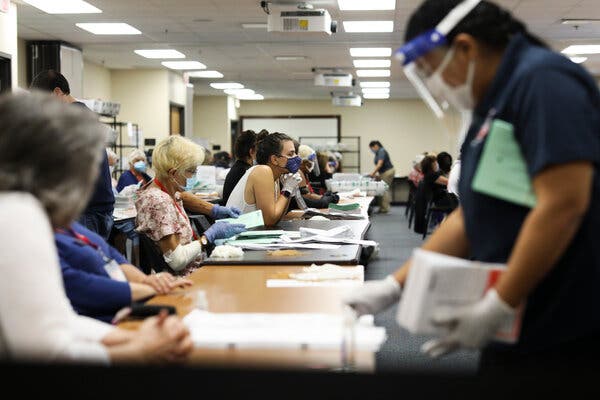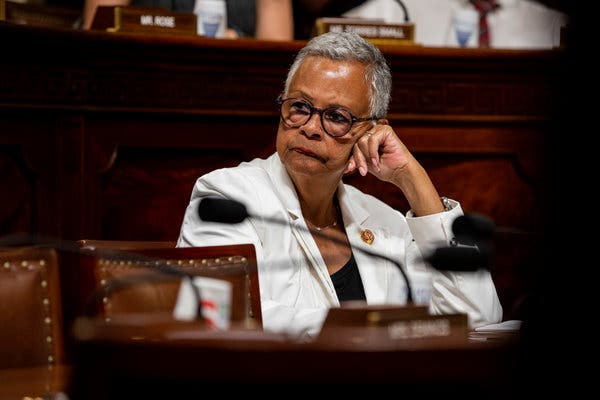Advertisement
Democrats lead in overall numbers, as well as early voting, but voter registration gains in three critical states have given Republicans a cause for hope.

With President Trump trailing in public polls in nearly every major battleground state, Republicans are pointing to what they see as more promising data: Updated voter registration tallies show that Republicans have narrowed the gap with Democrats in three critical states.
As the presidential campaign heads into its final weeks, Republicans hope that gains in voter registration in the three states — Florida, North Carolina and Pennsylvania — and heavy turnout by those new party members might just be enough to propel Mr. Trump to a second term.
“The tremendous voter registration gain by the Republicans is the secret weapon that will make the difference for the Republicans in 2020,” said Dee Stewart, a Republican political consultant in North Carolina.
Overall, Democrats retain a lead in total registrations in those three states and hold a significant advantage in early turnout. Democrats also have picked up voters in Arizona, a state Mr. Trump won by 91,000 votes in 2016 but where Joseph R. Biden Jr., the Democratic presidential nominee, now leads in the polls. In New Hampshire, another battleground where public polls also show Mr. Biden in the lead, Democrats have overtaken Republicans in the registered voter count for the first time since 2010, now leading 332,000 to 310,000.
Voter registration numbers alone are not predictive about the outcome of races: Democrats had a surge in voter registrations in 2018, and went on to win the House of Representatives but lost some races in key states where they had an overall registration edge. Democrats also led Republicans in voter registration in several key states in 2016 that they ended up losing. Party registrations are driven in some states by local and congressional races as much as the presidential race, too.
The Trump-Biden contest this fall may be driven less by incremental changes in registration than by who turns out to vote, and how much they want the president to have a second term or not. And the difference of a point or two in voter registration only makes a difference in a close race.
Analyzing voter registration — and how it might affect the outcome of the looming election — is also complicated by the fact that a number of states permit same-day voter registration. In addition, at least six battleground states — Georgia, Michigan, Minnesota, Ohio, Texas and Wisconsin — do not break down voter registration by party, though Democrats point to some perceived gains there.
In Georgia, for example, of the 800,000 voters who have registered since 2018, 49 percent are people of color, according to the organization Fair Fight, which was founded by Stacey Abrams, a Democrat who narrowly lost the race for governor in the state in 2018.
“Those are Democratic-leaning voters,” Ms. Abrams said during an appearance last week with Jill Biden, Mr. Biden’s wife, in suburban Atlanta, where early-voting turnout is setting records.
In their optimism regarding the registration data, Republicans point first to Florida, the largest battleground state, which has 29 electoral votes.
Polls show Mr. Biden narrowly leading in the state, which Mr. Trump won by 113,000 votes in 2016, but Republicans say the increase in registered voters there has the potential to give the president an edge.
In data released last week by the Florida secretary of state’s office, Republicans had narrowed the registration chasm with Democrats to 134,000 out of 14.4 million voters — fewer than 1 percent. In 2016, when Hillary Clinton, the Democratic nominee, lost the state to Mr. Trump, Democrats held a 330,000-voter advantage.
Mac Stevenson, a Republican political consultant in Florida, said the increase in registration could be viewed only as a positive sign for Republicans.
“I think it augurs that there’s going to be increased Republican turnout, but you have to balance that against the fact that everyone’s turning out more,” Mr. Stevenson said, pointing out that Democrats have historically lagged in turnout.
Aubrey Jewett, a professor of political science at the University of Central Florida, said the registration numbers in Florida reflected a significant effort by Republicans.

“They have made it clear that, despite the pandemic, they were going to still knock on doors and register voters,” he said.
At the same time, Dr. Jewett said, Democratic voter registration was probably handicapped by a protracted court battle over whether felons would have to pay outstanding fines to restore their voting rights.
“I think Democrats were somewhat hopeful that there were going to be more felons that regained voting rights and actually registered,” he said. “That ended up not being a huge boost.”



